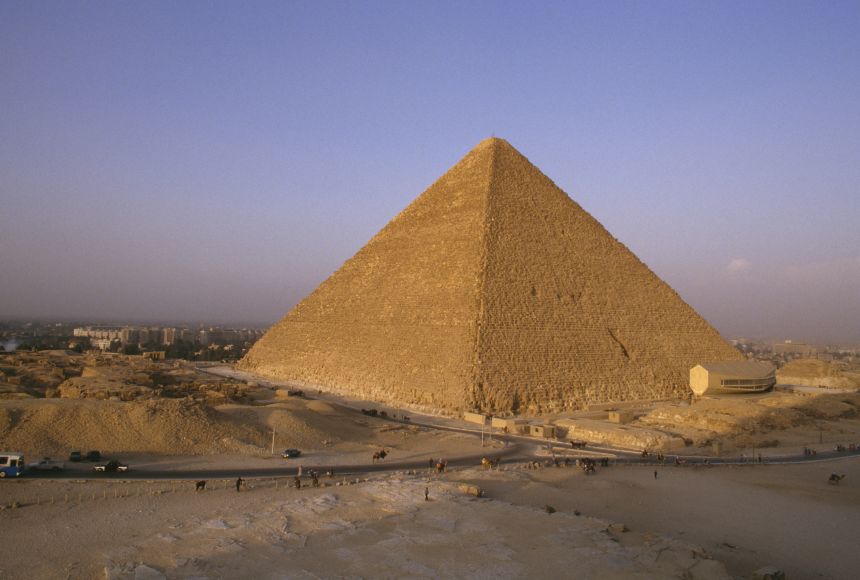The Seven Wonders of the Ancient World, which were selected by ancient Greek travelers, appeared in poetry and art. They demonstrate human imagination, technology, and how ancient civilizations impacted the world.
There are many monuments that tell stories of human achievement throughout history. Among these, only seven are known as "wonders" that exemplify the contributions of ancient Mediterranean and Middle Eastern civilizations.
The Seven Wonders of the Ancient World were chosen by Greek travelers passing through Persian, Babylonian, and Egyptian lands. These lands covered much of the modern-day Middle East. Travelers described the wonders in travel guides, artwork, and poems. Although a list of wonders appears as early as the 5th century B.C.E., the most famous example was created in the second century B.C.E. when the Greek writer Antipater of Sidon celebrated the Seven Wonders in poetry.
While these constructions are stunning achievements of ancient engineerning, they don't include marvels from many of the ancient civilizations of Africa, Europe, and Asia, and the Americas, which were unknown to the Hellenic peoples.
The Seven Wonders are still celebrated today, but only one remains standing. The wonders hence show the fleeting nature of even the grandest human achievements.
Great Pyramid of Giza
The Great Pyramid is the only Wonder that still exists today, and for nearly 4,000 years it stood as the world's tallest man-made structure. The Great Pyramid was erected around 2560 B.C.E. on the west bank of the Nile River in Egypt; the people of that time called their nation Kemet. The pyramid served as a tomb for Pharaoh Khufu, also known as Cheops.
The proportions of the pyramid are colossal even by modern standards. The original height was around 147 meters (482 feet), though time has worn away the height to around 138 meters (451 feet). That is approximately the same height as the Los Angeles City Hall, a building with 32 floors. The length of each side at the base averages around 230 meters (756 feet), more than two football fields. The Pyramid took more than 20 years to construct, using about 2.3 million stone blocks.
Hanging Gardens of Babylon
Although the Hanging Gardens of Babylon were named one of the Seven Ancient Wonders, there is not much first-hand evidence that the gardens actually existed. Those who claimed to have seen the gardens in Babylon described them as marvels of engineering. Blooming flowers, luscious fruit, foliage, and impressive waterfalls were said to have filled them. The hanging gardens were believed to have been built around 600 B.C.E. by King Nebuchadnezzar II. They were located in modern-day Iraq.
Statue of Zeus
Phidias was the most celebrated sculptor of ancient Greece. He created a statue of the god Zeus, the king of the ancient Greek gods. Housed in the Temple of Zeus in Olympia, the statue showed Zeus seated on a throne lavishly decorated with gold and precious gems.
The statue was 12 meters (40 feet) high, almost as tall as a three-story building. Many of those who viewed the statue commented that Zeus was too large in relation to the entire temple. Regardless, most viewers admired the statue as a stunning representation of the great god. However, it was destroyed in an earthquake in the 5th century B.C.E.
Temple of Artemis
The Temple of Artemis was constructed in what is now western Turkey. The temple was so magnificent the writer and engineer Philo of Byzantium said that while he had seen other wonders, "when I saw the temple rising to the clouds, all other wonders were put in the shade."
The temple, first constructed to honor the Greek goddess of the hunt, became a holy place of worship. The temple went through several phases of destruction and rebuilding. The most famous version, completed in 550 B.C.E., was about 115 meters (377 feet) long, which is more than a football field. The temple included 127 columns and was decorated with fine sculptures and paintings.
The arsonist Herostratus burned down the temple, and today only a few remains still stand.
Mausoleum of Halicarnassus
The Mausoleum of Halicarnassus was an impressive structure to house the dead. Designed by Greek architects around 350 B.C.E., the mausoleum honored a Babylonian governor and was located in what is now Turkey.
The mausoleum, which was approximately 41 meters (135 feet) tall, was adorned with carvings. Despite standing for centuries and surviving a raid by Alexander of Macedonia, a series of earthquakes finally destroyed it. All that remains are a few scattered pieces of its foundation.
Colossus of Rhodes
In ancient times, visitors to the Greek island of Rhodes were greeted by a statue of the god Helios. The statue was erected between 292 and 280 B.C.E. and stood at about 33 meters (105 to 110 feet). The statue was a victory monument honoring the defeat of an invading army in 304 B.C.E.
After standing for only 56 years, the statue was destroyed by an earthquake in 224 B.C.E.
Pharos (Lighthouse) of Alexandria
This ancient lighthouse is considered a technical masterpiece that served as the model for all lighthouses that followed. The lighthouse was completed between 285 and 247 B.C.E. on Pharos, an island in Egypt.
Standing more than 107 meters (350 feet) tall, the lighthouse was intended to be a landmark to help voyagers navigate the Egyptian coast. The lighthouse included a mirror to reflect sunlight during the day. At night, a fire was lit to guide travelers.
The Lighthouse of Alexandria was severely damaged by earthquakes in C.E. 965, 1303, and 1323. It was completely gone by 1480. Today, visitors to the place where the lighthouse once stood encounter an Egyptian fort built using some of the stones from the ruins.

